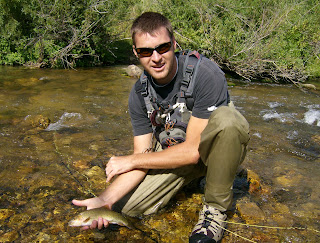

When we're young, we live on passion. We think we are old. Someone told us that when we are eighteen or twenty-one we are adults. But we are young and dumb. Everything is seen in tunnel-vision. I saw only desire and it was physical. So, how do we come to know something? We jump in with both feet--we get them wet, right? Then we learn that is not the way. We learn to take our time. We think, we feel, we lift rocks and we watch.
 River stones move with geologic speed. We don't have that luxury. Our time is a slap! It's quick and stings for a second then it's gone. In the speed of life, how do we live it to its fullest?
River stones move with geologic speed. We don't have that luxury. Our time is a slap! It's quick and stings for a second then it's gone. In the speed of life, how do we live it to its fullest?

 Common color names never do justice to what is really seen. Speckled trout eat there fill and fatten for the lethargic times of sparseness. When the leaves of Fall spin toward the water, the season ends. It's time to sleep.
Common color names never do justice to what is really seen. Speckled trout eat there fill and fatten for the lethargic times of sparseness. When the leaves of Fall spin toward the water, the season ends. It's time to sleep.
 River stones move with geologic speed. We don't have that luxury. Our time is a slap! It's quick and stings for a second then it's gone. In the speed of life, how do we live it to its fullest?
River stones move with geologic speed. We don't have that luxury. Our time is a slap! It's quick and stings for a second then it's gone. In the speed of life, how do we live it to its fullest?
What part do we drink to quench thirst? What part do we spew from our mouths? How do we unravel a braided current? We can't keep on casting until a trout will rise. We move on.
We can't keep on casting until a trout will rise. We move on.
 We can't keep on casting until a trout will rise. We move on.
We can't keep on casting until a trout will rise. We move on. This was a two day trip. The first day I went alone but in my mind a string provided a connection to others. The second day, my wife was my partner.
The river became moving art. I studied the painting. I wondered: where is the pallet that stores the colors? The colors melt and run over rocks and stones. Wetness creates the brilliance. Look at the grayness of the exposed rocks. It's the water that paints the picture.
Some creeks run dry. They are a waste of time. Someone once told me that to look at them can bring sadness. I agree. Rear tires slip and spin--another goose chase. It's time to head for the familiar--it's safe there like an old friend. There's a calmness in the sound of familiar water; a calmness in a friend's voice. The serenity of place is often measured by past experience there. The small subtle changes become apparent with familiarity. The big picture may not seem to change to the casual observer.
On these creeks fly lines are not often airborn in long flowing loops. There is no need. Control of the passion for length and the need for rhythm are haulted. Trees and brush stiffle the need for power. Flips, rolls, dapping, and mends shake off the end of the rod. Much of the time, the fly line is held high and out of the water as leader and tippet dance upon seams and eddies.
Rises are quick. No time to daydream. When the fly hits the water, the reaction is now! With little weight the trout is lifted from it's world. The release is just as quick and the trout darts away with much of its liveliness.
The small creeks are not hard to read. Almost every likely looking spot will hold a trout. Presentation can be difficult if you are not used to casting around trees, brush, and snags. The things they teach in casting classes or on the casting platforms at the sportsmen's shows will serve you no good here. The late Gary LaFontaine taught it right. Standing upon the casting paltform, he would stroke a line out about one-hundred feet to the cheers of the spectators. Then he would say, "let me show you how to catch a trout now." He would kneel down behind the platform and throw out a fifteen foot cast and then talk about stealth and pinpoint casting.
Familiar water feels good. After a long winter, spring, and sometimes summer, the fall season is the time to dance with the well-known. There's a small window of opportunity when it's possible to chat with nature. When things are still. The sky stays blue. Then, just at the right time the quakie leaves will shake, and whisper of cool nights and shorter days.
The colors from the river rock and trout will mix with the terrestrial landscape. It happens with a blink. This is the time to fish hard.
 Common color names never do justice to what is really seen. Speckled trout eat there fill and fatten for the lethargic times of sparseness. When the leaves of Fall spin toward the water, the season ends. It's time to sleep.
Common color names never do justice to what is really seen. Speckled trout eat there fill and fatten for the lethargic times of sparseness. When the leaves of Fall spin toward the water, the season ends. It's time to sleep..jpg)











